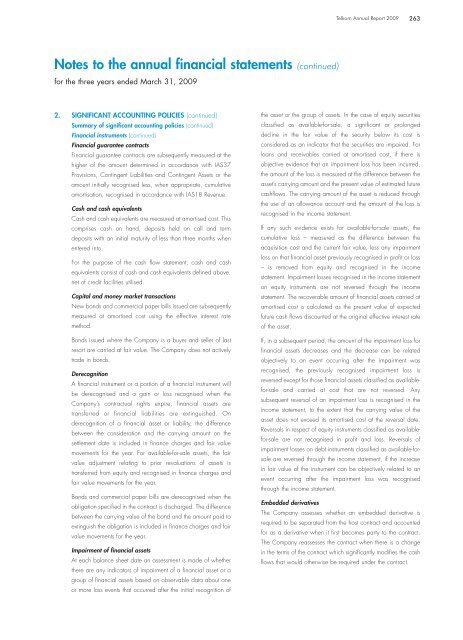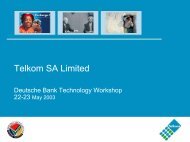Telkom AR front.qxp
Telkom AR front.qxp
Telkom AR front.qxp
You also want an ePaper? Increase the reach of your titles
YUMPU automatically turns print PDFs into web optimized ePapers that Google loves.
Notes to the annual financial statements (continued)<br />
for the three years ended March 31, 2009<br />
2. SIGNIFICANT ACCOUNTING POLICIES (continued)<br />
Summary of significant accounting policies (continued)<br />
Financial instruments (continued)<br />
Financial guarantee contracts<br />
Financial guarantee contracts are subsequently measured at the<br />
higher of the amount determined in accordance with IAS37<br />
Provisions, Contingent Liabilities and Contingent Assets or the<br />
amount initially recognised less, when appropriate, cumulative<br />
amortisation, recognised in accordance with IAS18 Revenue.<br />
Cash and cash equivalents<br />
Cash and cash equivalents are measured at amortised cost. This<br />
comprises cash on hand, deposits held on call and term<br />
deposits with an initial maturity of less than three months when<br />
entered into.<br />
For the purpose of the cash flow statement, cash and cash<br />
equivalents consist of cash and cash equivalents defined above,<br />
net of credit facilities utilised.<br />
Capital and money market transactions<br />
New bonds and commercial paper bills issued are subsequently<br />
measured at amortised cost using the effective interest rate<br />
method.<br />
Bonds issued where the Company is a buyer and seller of last<br />
resort are carried at fair value. The Company does not actively<br />
trade in bonds.<br />
Derecognition<br />
A financial instrument or a portion of a financial instrument will<br />
be derecognised and a gain or loss recognised when the<br />
Company’s contractual rights expire, financial assets are<br />
transferred or financial liabilities are extinguished. On<br />
derecognition of a financial asset or liability, the difference<br />
between the consideration and the carrying amount on the<br />
settlement date is included in finance charges and fair value<br />
movements for the year. For available-for-sale assets, the fair<br />
value adjustment relating to prior revaluations of assets is<br />
transferred from equity and recognised in finance charges and<br />
fair value movements for the year.<br />
Bonds and commercial paper bills are derecognised when the<br />
obligation specified in the contract is discharged. The difference<br />
between the carrying value of the bond and the amount paid to<br />
extinguish the obligation is included in finance charges and fair<br />
value movements for the year.<br />
Impairment of financial assets<br />
At each balance sheet date an assessment is made of whether<br />
there are any indicators of impairment of a financial asset or a<br />
group of financial assets based on observable data about one<br />
or more loss events that occurred after the initial recognition of<br />
<strong>Telkom</strong> Annual Report 2009 263<br />
the asset or the group of assets. In the case of equity securities<br />
classified as available-for-sale, a significant or prolonged<br />
decline in the fair value of the security below its cost is<br />
considered as an indicator that the securities are impaired. For<br />
loans and receivables carried at amortised cost, if there is<br />
objective evidence that an impairment loss has been incurred,<br />
the amount of the loss is measured at the difference between the<br />
asset’s carrying amount and the present value of estimated future<br />
cashflows. The carrying amount of the asset is reduced through<br />
the use of an allowance account and the amount of the loss is<br />
recognised in the income statement.<br />
If any such evidence exists for available-for-sale assets, the<br />
cumulative loss – measured as the difference between the<br />
acquisition cost and the current fair value, less any impairment<br />
loss on that financial asset previously recognised in profit or loss<br />
– is removed from equity and recognised in the income<br />
statement. Impairment losses recognised in the income statement<br />
on equity instruments are not reversed through the income<br />
statement. The recoverable amount of financial assets carried at<br />
amortised cost is calculated as the present value of expected<br />
future cash flows discounted at the original effective interest rate<br />
of the asset.<br />
If, in a subsequent period, the amount of the impairment loss for<br />
financial assets decreases and the decrease can be related<br />
objectively to an event occurring after the impairment was<br />
recognised, the previously recognised impairment loss is<br />
reversed except for those financial assets classified as availablefor-sale<br />
and carried at cost that are not reversed. Any<br />
subsequent reversal of an impairment loss is recognised in the<br />
income statement, to the extent that the carrying value of the<br />
asset does not exceed its amortised cost at the reversal date.<br />
Reversals in respect of equity instruments classified as availablefor-sale<br />
are not recognised in profit and loss. Reversals of<br />
impairment losses on debt instruments classified as available-forsale<br />
are reversed through the income statement, if the increase<br />
in fair value of the instrument can be objectively related to an<br />
event occurring after the impairment loss was recognised<br />
through the income statement.<br />
Embedded derivatives<br />
The Company assesses whether an embedded derivative is<br />
required to be separated from the host contract and accounted<br />
for as a derivative when it first becomes party to the contract.<br />
The Company reassesses the contract when there is a change<br />
in the terms of the contract which significantly modifies the cash<br />
flows that would otherwise be required under the contract.




